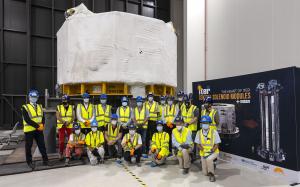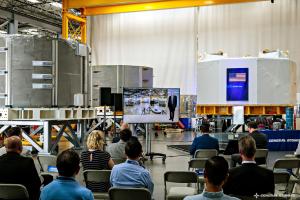1st delivery celebrated on both sides of the Atlantic
Standing 18 metres tall at the very heart of the ITER Tokamak, the central solenoid will generate an intense magnetic field which, in turn, will induce an electrical current inside the plasma and initiate the heating process that will ultimately allow fusion reactions to happen.
The central solenoid is the most emblematic of all the contributions óf the United States to the ITER Project. Fabrication of the modules began nearly ten years ago at a General Atomics facility created expressly for the purpose—the Magnet Technologies Center close to San Diego, California.
The first of the completed modules left the factory on 21 June this year, travelled more than 2,400 kilometres by road to the port of Houston, Texas, and then crossed the Atlantic, reaching southern France on 27 July. Last week, in the early hours of Thursday 9 September, the 110-tonne component passed the gates of the ITER construction site where it will be placed in storage to wait for its siblings. A second module took to the sea earlier this month and is expected at ITER in November.
By late afternoon, with the module safely in stillage, a small ceremony was organized with the virtual presence of representatives from US ITER, General Atomics and the US Department of Energy.
Tim Luce, ITER Head of Science & Operation since 2017 and a former senior scientist at General Atomics, reminisced about the formidable industrial endeavour of building this first-of-a-kind component. Standing in front of the module, he said: "We have retired the risk of 'Can it be done?' The component is right here to prove that. But what you can't see are the late nights, the weekends, the anxiety during the testing phases that went into the making of this magnet."
Speaking from Washington, James Van Dam, the head of Fusion Energy Sciences at the US Department of Energy, praised the "great job" from General Atomics and the "close working relationship" between US ITER, the Japanese Domestic Agency (which provided the 43 kilometres of niobium-tin conductor required for the central solenoid) and the ITER Organization. "ITER," he said, "represents world-changing science. It will indeed transform the world."
From Oak Ridge, Tennessee, US ITER Director Kathy McCarthy stressed the value of the experience gained by this endeavour. "It not only supports the achievement of the ITER mission, but will also inform future fusion and high-power magnet endeavours. Building 'the heart of ITER' yields hands-on experience and insight for precise fusion engineering and manufacturing."
The effort, however, does not end here. "Now, we turn to 'Can we get the other modules in time?' and 'Can we assemble them properly?'" Tim Luce concluded.
The challenge will keep the teams busy for close to two and a half years.
Click here to view a video of the last leg of the module's journey.
Click here for a press release and a video of the US celebration on the General Atomics website.




